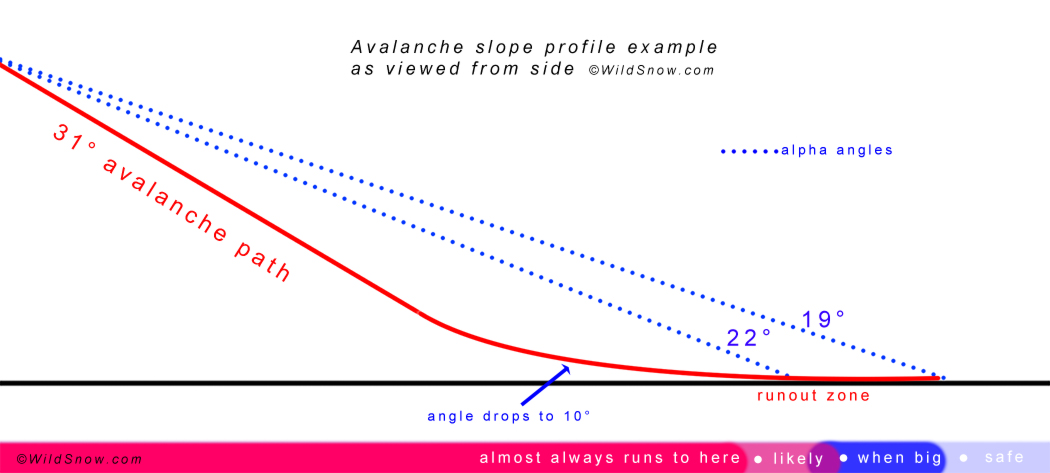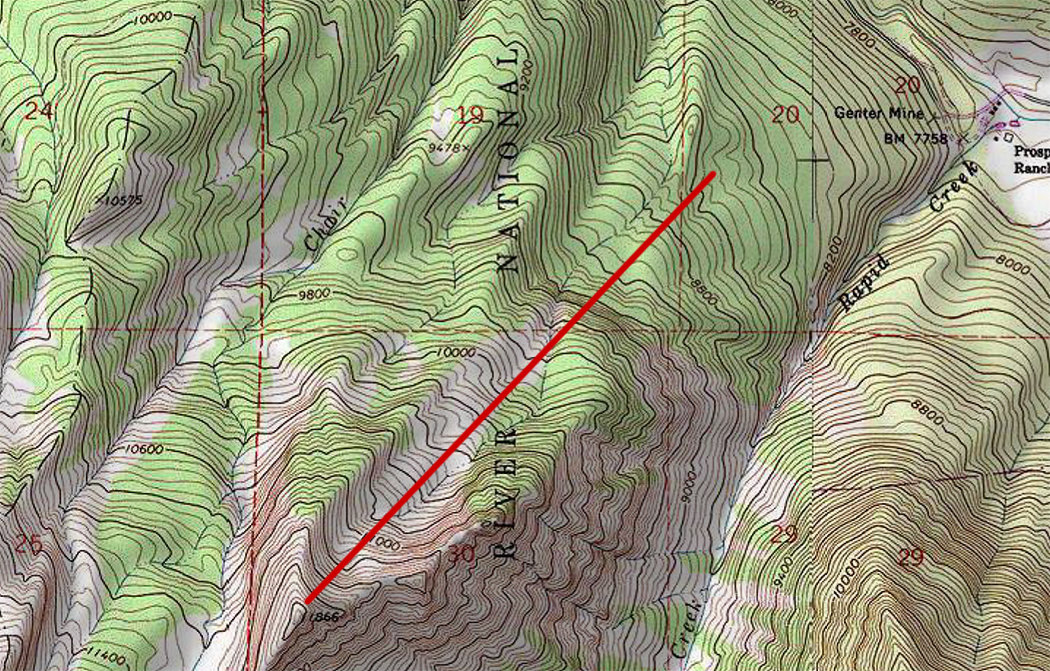Avalanches and alpha angles are worth considering when deciphering how far a potential avalanche will run. With this introduction to alpha angles from Lou Dawson, we become more avalanche aware. Be safe.
Editor’s Note:A version of this story was first published on WildSnow in 2014. Like many archived pieces, there’s still much to glean from a story refresh.
With the local avalanche center forecasting for “green”/ “low” avalanche likelihood this weekend, we ventured to find some north and NE-facing slopes for some cold snow. With some wind loading, despite no recent snow, the turns were great. Yet, despite the solid start to the season, the lower portion of the slopes we skied, which trend into a vast talus field, were still somewhat boney. We cut the run short by maybe 20 turns to save the ski/snowboard bases and keep the potential yard sales in check.
By cutting the run short on our last run, I was still on approximately 20-degree terrain and not directly under my partner’s soon-to-be-skied fall line when I traversed across the slope to tuck behind some snags. Even with the “low” avalanche forecast, the concept of alpha angle and avalanches popped into my head. Here’s Lou’s take on alpha angles. The original post, linked here, has a fruitful thread of comments to mine.
Some things in ski mountaineering take a high degree of mental acuity. Tech bindings might be one. Starting before 10:00 in the morning could also be an item for improvement.
But above all, sometimes, it takes a while to wrap your mind around the fact that snow avalanches are predictable in several ways. Thus, while luck and chance play a part in any aspect of life, it is not just chance or the luck of the draw that keeps you alive in avalanche country.
This is written from one backcountry skiing layman to another, with the simple purpose of conveying a concept I’ve found useful and practical over the years for increasing avalanche safety. I’m making no claim to any engineering or geology expertise here. Any mistakes in terminology or facts are mine, and mine alone, and I’ll correct them upon notification.
Avalanches behave according to natural physical laws involving mass under the influence of gravity and such. While it’s impossible down to inches to predict where an avalanche will stop moving (unless it goes up against a terrain feature), it is possible and quite easy to predict the maximum extent within a few hundred feet or less, depending on topography and some basic engineering concepts. Yep, we’re talking about alpha angle (also known by terms such as angle of reach). We’re talking about the learned skill of recognizing an avalanche slope and perhaps avoiding the runout, even in situations such as a high-altitude glacier with no vegetation clues.
Before we start with the details, if you don’t get this, here is the proof. All over the world, municipalities and land use planners in alpine regions zone or otherwise designate avalanche-safe areas in alpine topography. They don’t use magic to do this. They don’t use divining rods. They don’t just sit around and go “blah blah blah.” Instead, they have someone use a few simple techniques that give a very good idea of safe and unsafe areas. They refine this with engineering math if necessary, but anyone can do the basics.
Below depicts a huge avalanche path near McClure Pass, Colorado, known as the Cleaver. (A good spring corn snow skiing destination, by the way.) The lower trim line is easily spotted and results from a 100-year type of avalanche that occurred on January 12, 2005. How do we know it was a 100-year variety? It is because of the 100-year-old trees that were taken out.
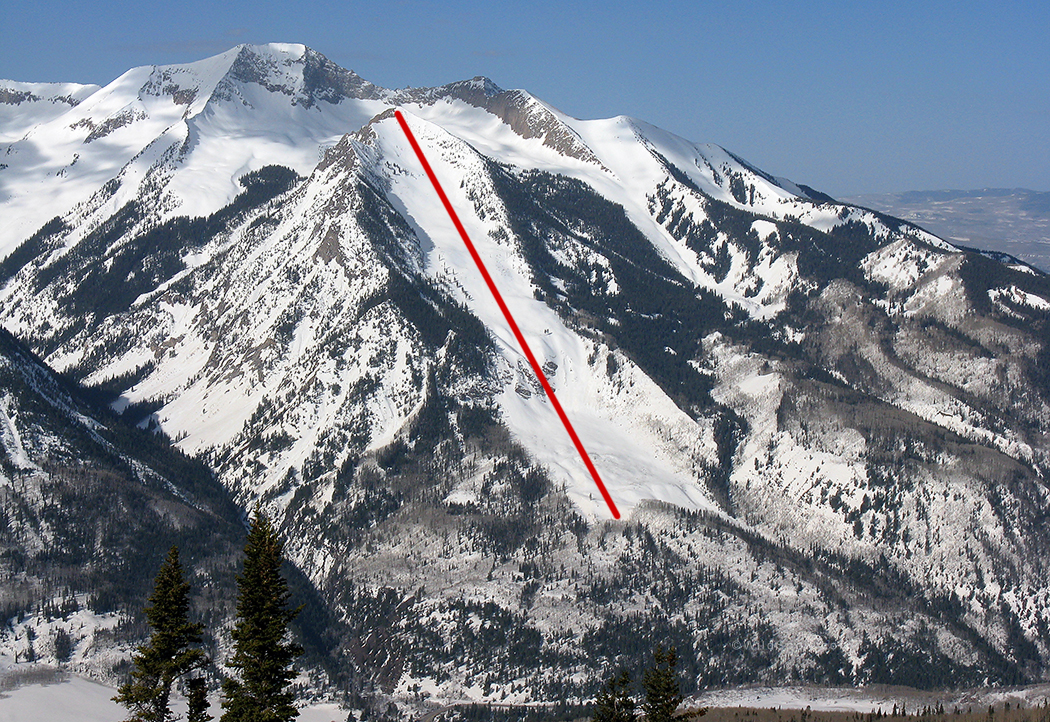
Cleaver avalanche path, extent of 2005 ‘full path’ slide is marked as one would shoot alpha angle if they were standing at the bottom next to the trees that were still standing.
To get your alpha angles at home in Google Earth, first draw a path from the top of the slide path starting zone to the point where you want to catch an alpha angle. After the path is created, just click Edit/Show-Elevation-Profile then convert the percentage grade to degrees.
Editor’s Note: depending on the mapping app platform you are using, you may be able to determine the angle in degrees in your preferred app. I can do this easily on the desktop version of FatMap, for example.
Determining Alpha Angle
So, how do you observe alpha angle in the field? Simple, just sight with an inclinometer (or trained eyeballs) to the top of the estimated starting zone, and estimate where the sight line intersects behind you (or lie down on the snow and sight). That’s all you need to get an idea of where you are in relation to the path runout. Hopefully, you do this when approaching the path from the bottom, as in, “Hey Salley, looks like my inclinometer is showing 16 degrees to the top of that avalanche path above us; let’s stop for lunch here before we get any closer.”
While approaching an avalanche path from the side, hold the inclinometer up and tilt it to align with the terrain. Angles become pretty obvious once you do this. If it’s cloudy and you can’t see the avalanche path above you? Different story, and you’ll depend totally on vegetation clues if they exist. If it’s all a total mystery due to visibility or strange terrain, that’s a fire alarm that, in many cases, would dictate a major route deviation or turning back (or very careful map reading).
It might go without saying, but I should emphasize that all this angle stuff depends on the general probability of avalanches from a given exposure based on avalanche forecasting factors. On a day with super low danger, you might charge ahead with very little fooling around with judging safe zones. During a day with high hazard, you might be figuring alpha angles numerous times as you progress your route. And to repeat, different regions and types of snowpack have different average alpha angles.
Beyond alpha angle, another sometimes esoteric concept is beta angle: this dictates the area of the path where the avalanche flows easily as opposed to “thinking” about stopping. It’s somewhat arbitrary and not something I find that useful. But others disagree, so it’s worth illustrating. See image below:
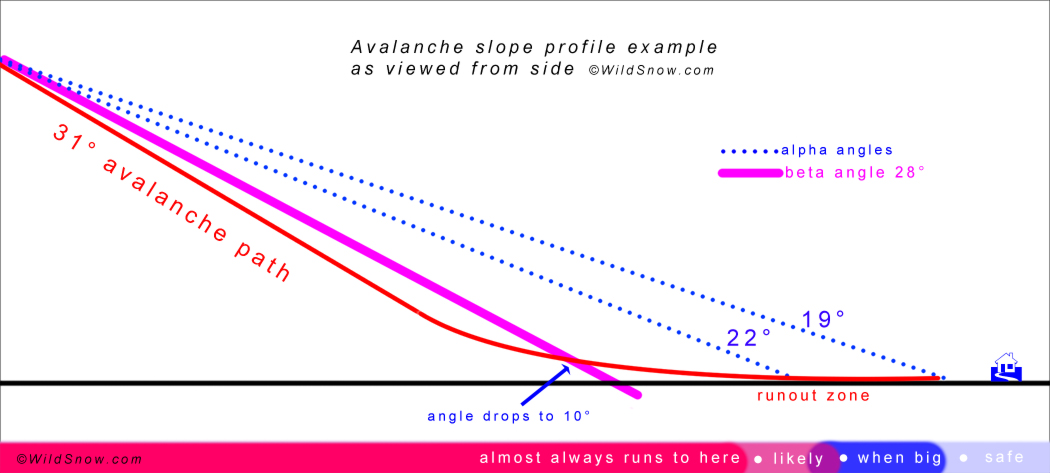
Beta angle in purple. It’s the imaginary line drawn from start to where the path reaches 10 degrees angle.
I want to emphasize a couple more things. First, yes, topography such as deep moats or vertical channeling can either reduce or extend flow, but smaller terrain features, like lower angled or shelf parts of the avalanche path, are figured into the overall alpha. In other words, if you look up a slope from the bottom and shoot the alpha angle from where you are, either with an inclinometer or just by eye, do not let changes in path angle or shelves have too much influence on your decision-making. The inclinometer doesn’t lie. Also, if you get a chance to observe powder slab avalanches, it is amazing how quickly they stop once they start approaching the lower alpha angle region. You can feel it when you’re in one; it’s like someone putting on the brakes. Again, physics, not chance.
Okay, over to you guys. Commenters, a challenge. Imagine you are above a timberline in Colorado and start heading towards an obviously loaded steep slope. Perhaps you’re going to Friends Hut from Ashcroft, a common route with several miles of above-timberline terrain that passes under avalanche paths — many of which have no vegetation clues as to where the runouts are located. You know it’s an avalanche slope you’re looking at because in your Avy 1 class you learned that anything this steep with snow on it is an avalanche slope. But can you determine how far from the bottom of the slope you need to stay to get to the hut without unnecessary risk?
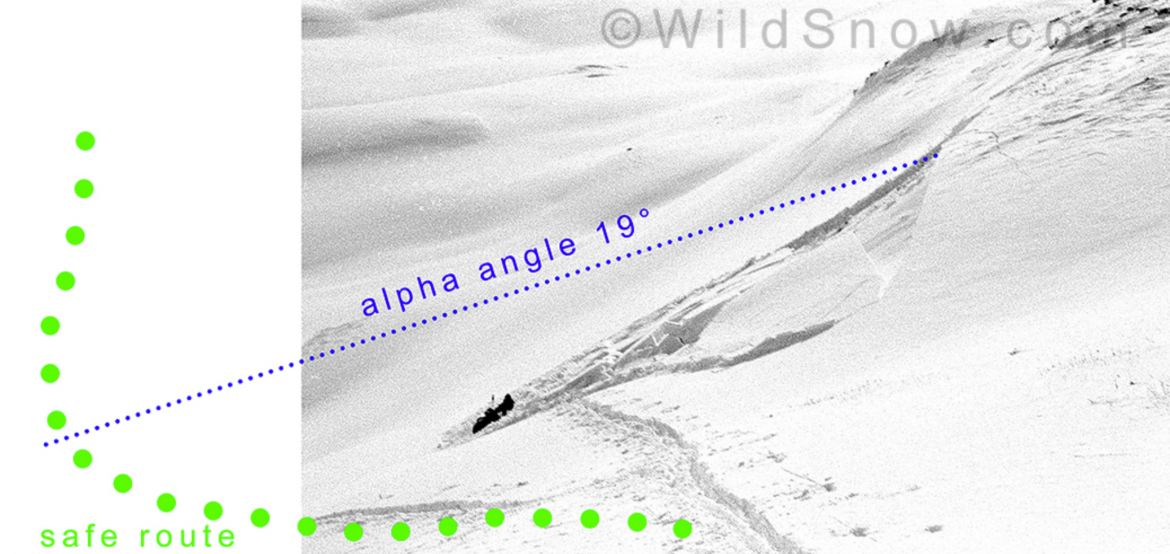
Here is a real life example. Small pocket avalanches can hurt you. This person had a wind slab flow around her feet and bury her skis, if she’d been higher up on the slope an injury could have resulted. As it was, she was scared but unharmed. This incident illustrates how important it is to judge your runout angles when you’re in places where vegetation doesn’t tell you where slide can go. The photo shows part of the route to Pearl Pass from Aspen side. At this particular spot, you can save a bit of energy by cutting up close to the wind roll, or you can drop perhaps 50 feet of vertical and swing around far enough away from the snow pillow to achieve an 18 or 19 degree alpha angle from the top of the avalanche slope to your track. Quite a few people have no ability to judge this without the use of an inclinometer. An experienced skier would tend to swing around lower, though it’s easy to get lazy and I’ll admit to that. This little thing actually taught me a big lesson about keeping up my guard and working better with groups. It’s a perfect example of how alpha angle can be used to predict safe routes — by experience or instrumentation.
Find more avalanche information on WildSnow.
WildSnow.com publisher emeritus and founder Lou (Louis Dawson) has a 50+ years career in climbing, backcountry skiing and ski mountaineering. He was the first person in history to ski down all 54 Colorado 14,000-foot peaks, has authored numerous books about about backcountry skiing, and has skied from the summit of Denali in Alaska, North America’s highest mountain.

